CALLICOON FINE ARTS
49 DELANCEY ST
NEW YORK, NY 10002
49 DELANCEY ST
NEW YORK, NY 10002
PRESS RELEASE
Utopia Landfill or Vacation in the Age of Sad Passion
November 5–December 23, 2016
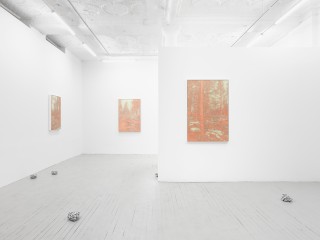
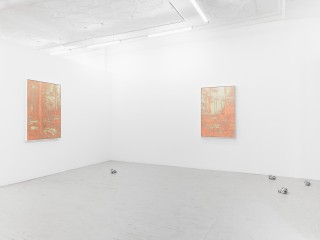
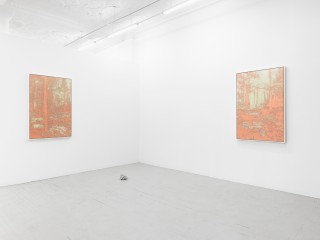
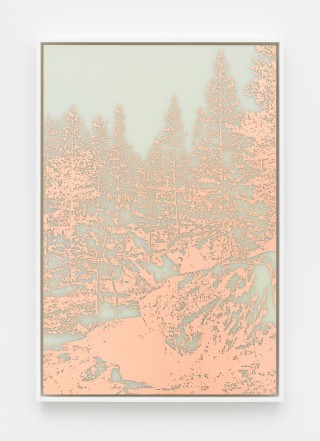
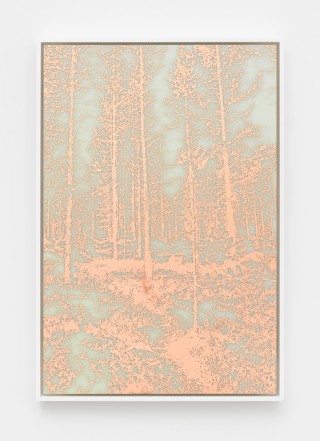
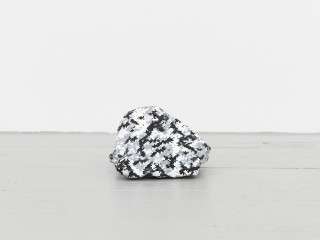
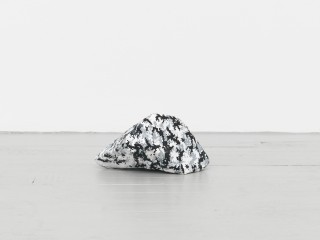
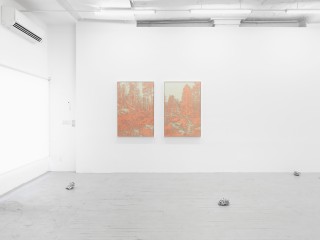


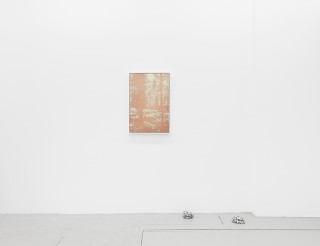
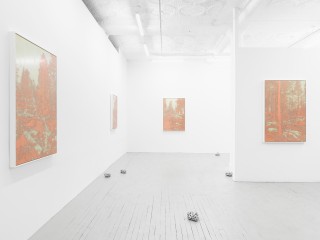
Callicoon Fine Arts is very pleased to present Utopia Landfill or Vacation in the Age of Sad Passion, James Hoff’s third exhibition with the gallery. Opening on November 5th, the exhibition features two new bodies of work, both of which ruminate on the evolving digitization of nature and the natural landscape. In the works shown here, the landscape painting genre is used to help define a contemporary environment ruled by the imperative of connectivity and computing.
Imagine the verdant outdoors, the trees, their myriad leaves, the fragrant sloping ground; organically all is alive, yet dead or useless when viewed through the lens of connectivity. This framework has subtly crept into our daily lives and has realigned our relationship to our environment.
Hoff set out to capture and record these landscapes using his cell phone in upstate New York and elsewhere over the last year. The result is a series of what the artist calls Useless Landscapes, which consist of etched copper on fiberglass, a material substrate used to make circuit boards. The process the artist employs to etch the works (using a silkscreen resist) is the same that electronic manufacturers use to make the circuit boards that drive our digital devices and is itself borrowed from the tradition of print making. Hoff redirects this material form and the circuit board production process back to that of aesthetics, disarming its digital functionality in an effort to record landscapes of network silence.
This series is underscored by an installation that is comprised of found stones and rocks that the artist has painted with an urban, digital camouflage using a hydrographic process. Hoff’s use of camouflage points to shifts in the development of visual technologies in the early 20th century (namely the development of aerial photography that allowed for wide scale environmental mapping) that necessitated and exacerbated the development of camouflage during the First World War. Artists lead the way to developing this new visual strategy in which military personnel and equipment were painted in shifting patterns in an effort to disappear into the landscape and remain hidden, or disconnected, from the camera above.
Hoff’s conflation of camouflage’s early mission with its contemporary digital counterpart also points to the use value of our mineral resources, which are now mined to build and maintain digital devices and hardware infrastructures, ensuring that a stroll through the forest is no longer a great escape but rather, a walk through the membrane of future computing. At this moment, hard drives are hiding in the landscape.
Imagine the verdant outdoors, the trees, their myriad leaves, the fragrant sloping ground; organically all is alive, yet dead or useless when viewed through the lens of connectivity. This framework has subtly crept into our daily lives and has realigned our relationship to our environment.
Hoff set out to capture and record these landscapes using his cell phone in upstate New York and elsewhere over the last year. The result is a series of what the artist calls Useless Landscapes, which consist of etched copper on fiberglass, a material substrate used to make circuit boards. The process the artist employs to etch the works (using a silkscreen resist) is the same that electronic manufacturers use to make the circuit boards that drive our digital devices and is itself borrowed from the tradition of print making. Hoff redirects this material form and the circuit board production process back to that of aesthetics, disarming its digital functionality in an effort to record landscapes of network silence.
This series is underscored by an installation that is comprised of found stones and rocks that the artist has painted with an urban, digital camouflage using a hydrographic process. Hoff’s use of camouflage points to shifts in the development of visual technologies in the early 20th century (namely the development of aerial photography that allowed for wide scale environmental mapping) that necessitated and exacerbated the development of camouflage during the First World War. Artists lead the way to developing this new visual strategy in which military personnel and equipment were painted in shifting patterns in an effort to disappear into the landscape and remain hidden, or disconnected, from the camera above.
Hoff’s conflation of camouflage’s early mission with its contemporary digital counterpart also points to the use value of our mineral resources, which are now mined to build and maintain digital devices and hardware infrastructures, ensuring that a stroll through the forest is no longer a great escape but rather, a walk through the membrane of future computing. At this moment, hard drives are hiding in the landscape.
CALLICOON FINE ARTS
49 DELANCEY ST
NEW YORK, NY 10002
49 DELANCEY ST
NEW YORK, NY 10002
PRESS RELEASE
Utopia Landfill or Vacation in the Age of Sad Passion
November 5–December 23, 2016












Callicoon Fine Arts is very pleased to present Utopia Landfill or Vacation in the Age of Sad Passion, James Hoff’s third exhibition with the gallery. Opening on November 5th, the exhibition features two new bodies of work, both of which ruminate on the evolving digitization of nature and the natural landscape. In the works shown here, the landscape painting genre is used to help define a contemporary environment ruled by the imperative of connectivity and computing.
Imagine the verdant outdoors, the trees, their myriad leaves, the fragrant sloping ground; organically all is alive, yet dead or useless when viewed through the lens of connectivity. This framework has subtly crept into our daily lives and has realigned our relationship to our environment.
Hoff set out to capture and record these landscapes using his cell phone in upstate New York and elsewhere over the last year. The result is a series of what the artist calls Useless Landscapes, which consist of etched copper on fiberglass, a material substrate used to make circuit boards. The process the artist employs to etch the works (using a silkscreen resist) is the same that electronic manufacturers use to make the circuit boards that drive our digital devices and is itself borrowed from the tradition of print making. Hoff redirects this material form and the circuit board production process back to that of aesthetics, disarming its digital functionality in an effort to record landscapes of network silence.
This series is underscored by an installation that is comprised of found stones and rocks that the artist has painted with an urban, digital camouflage using a hydrographic process. Hoff’s use of camouflage points to shifts in the development of visual technologies in the early 20th century (namely the development of aerial photography that allowed for wide scale environmental mapping) that necessitated and exacerbated the development of camouflage during the First World War. Artists lead the way to developing this new visual strategy in which military personnel and equipment were painted in shifting patterns in an effort to disappear into the landscape and remain hidden, or disconnected, from the camera above.
Hoff’s conflation of camouflage’s early mission with its contemporary digital counterpart also points to the use value of our mineral resources, which are now mined to build and maintain digital devices and hardware infrastructures, ensuring that a stroll through the forest is no longer a great escape but rather, a walk through the membrane of future computing. At this moment, hard drives are hiding in the landscape.
Imagine the verdant outdoors, the trees, their myriad leaves, the fragrant sloping ground; organically all is alive, yet dead or useless when viewed through the lens of connectivity. This framework has subtly crept into our daily lives and has realigned our relationship to our environment.
Hoff set out to capture and record these landscapes using his cell phone in upstate New York and elsewhere over the last year. The result is a series of what the artist calls Useless Landscapes, which consist of etched copper on fiberglass, a material substrate used to make circuit boards. The process the artist employs to etch the works (using a silkscreen resist) is the same that electronic manufacturers use to make the circuit boards that drive our digital devices and is itself borrowed from the tradition of print making. Hoff redirects this material form and the circuit board production process back to that of aesthetics, disarming its digital functionality in an effort to record landscapes of network silence.
This series is underscored by an installation that is comprised of found stones and rocks that the artist has painted with an urban, digital camouflage using a hydrographic process. Hoff’s use of camouflage points to shifts in the development of visual technologies in the early 20th century (namely the development of aerial photography that allowed for wide scale environmental mapping) that necessitated and exacerbated the development of camouflage during the First World War. Artists lead the way to developing this new visual strategy in which military personnel and equipment were painted in shifting patterns in an effort to disappear into the landscape and remain hidden, or disconnected, from the camera above.
Hoff’s conflation of camouflage’s early mission with its contemporary digital counterpart also points to the use value of our mineral resources, which are now mined to build and maintain digital devices and hardware infrastructures, ensuring that a stroll through the forest is no longer a great escape but rather, a walk through the membrane of future computing. At this moment, hard drives are hiding in the landscape.